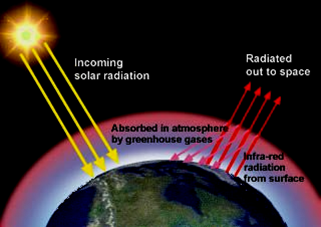
Over a long period of time, Earth's temperature is set by a balance between incoming radiation (mostly visible light) from the Sun and outgoing radiation (mostly infrared light invisible to the human eye) from the Earth. The hotter the Earth, the more it will radiate. If the Earth doesn't radiate enough infrared to balance the incoming sunlight, the excess sunlight will heat up the Earth, so the infrared emissions will increase till there is balance.

The importance of this greenhouse effect to the atmosphere is uncontroversial. Average temperature of the Earth is around 15oC, but without the trapping of radiation would be more like -18oC.
Doubling the atmospheric concentration of CO2 will warm the Earth by something like 2-4oK. This is only about a 1% change from the Earth's surface temperature of 288oK on the Kelvin temperature scale. Thus human-induced changes in CO2 and other gases are expected to make a small change in the absolute temperature of the Earth, but one which is larger than any in recorded history and which may bring massive changes to ecosystems and society.
Next: How sensitive is climate to greenhouse gas?Last modified: 21 July 2018